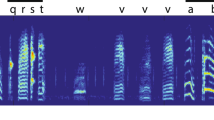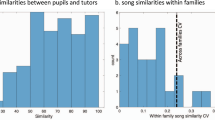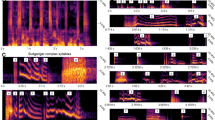Abstract
Human language, as well as birdsong, relies on the ability to arrange vocal elements in new sequences. However, little is known about the ontogenetic origin of this capacity. Here we track the development of vocal combinatorial capacity in three species of vocal learners, combining an experimental approach in zebra finches (Taeniopygia guttata) with an analysis of natural development of vocal transitions in Bengalese finches (Lonchura striata domestica) and pre-lingual human infants. We find a common, stepwise pattern of acquiring vocal transitions across species. In our first study, juvenile zebra finches were trained to perform one song and then the training target was altered, prompting the birds to swap syllable order, or insert a new syllable into a string. All birds solved these permutation tasks in a series of steps, gradually approximating the target sequence by acquiring new pairwise syllable transitions, sometimes too slowly to accomplish the task fully. Similarly, in the more complex songs of Bengalese finches, branching points and bidirectional transitions in song syntax were acquired in a stepwise fashion, starting from a more restrictive set of vocal transitions. The babbling of pre-lingual human infants showed a similar pattern: instead of a single developmental shift from reduplicated to variegated babbling (that is, from repetitive to diverse sequences), we observed multiple shifts, where each new syllable type slowly acquired a diversity of pairwise transitions, asynchronously over development. Collectively, these results point to a common generative process that is conserved across species, suggesting that the long-noted gap between perceptual versus motor combinatorial capabilities in human infants1 may arise partly from the challenges in constructing new pairwise vocal transitions.
This is a preview of subscription content, access via your institution
Access options
Subscribe to this journal
Receive 51 print issues and online access
$199.00 per year
only $3.90 per issue
Buy this article
- Purchase on Springer Link
- Instant access to full article PDF
Prices may be subject to local taxes which are calculated during checkout




Similar content being viewed by others
References
Marcus, G. F., Vijayan, S., Bandi Rao, S. & Vishton, P. M. Rule learning by seven-month-old infants. Science 283, 77–80 (1999)
Berwick, R. C., Okanoya, K., Beckers, G. J. L. & Bolhuis, J. J. Songs to syntax: the linguistics of birdsong. Trends Cogn. Sci. 15, 113–121 (2011)
Eales, L. Song learning in zebra finches: some effects of song model availability on what is learnt and when. Anim. Behav. 33, 1293–1300 (1985)
Plamondon, S. L., Rose, G. J. & Goller, F. Roles of syntax information in directing song development in white-crowned sparrows (Zonotrichia leucophrys). J. Comp. Psychol. 124, 117–132 (2010)
Derégnaucourt, S., Mitra, P. P., Fehér, O., Pytte, C. & Tchernichovski, O. How sleep affects the developmental learning of bird song. Nature 433, 710–716 (2005)
Tchernichovski, O., Nottebohm, F., Ho, C. E., Pesaran, B. & Mitra, P. P. A procedure for an automated measurement of song similarity. Anim. Behav. 59, 1167–1176 (2000)
Yamashita, Y. et al. Developmental learning of complex syntactical song in the Bengalese finch: a neural network model. Neural Netw. 21, 1224–1231 (2008)
Oller, D. K. in Child Phonology Vol. 1 (eds Yeni-Komshian, G. J., Kavanagh, J. & Ferguson, C. ) 93–112 (Academic, 1980)
Stark, R. in Child Phonology Vol. 1 (eds Yeni-Komshian, G. J., Kavanagh, J. & Ferguson, C. ) 73–92 (Academic, 1980)
Mitchell, P. R. & Kent, R. D. Phonetic variation in multisyllable babbling. J. Child Lang. 17, 247–265 (1990)
Smith, B. L., Brown-Sweeney, S. & Stoel-Gammon, C. A quantitative analysis of reduplicated and variegated babbling. First Lang. 9, 175–189 (1989)
MacWhinney, B. The CHILDES project: tools for analyzing talk. Child Lang. Teach. Ther. 8, 217–218 (1992)
Davis, B. L. & MacNeilage, P. F. The articulatory basis of babbling. J. Speech Hear. Res. 38, 1199–1211 (1995)
Edelman, G. Neural Darwinism. The Theory of Neuronal Group Selection (Basic Books, 1987)
Hanuschkin, A., Diesmann, M. & Morrison, A. A reafferent and feed-forward model of song syntax generation in the Bengalese finch. J. Comput. Neurosci. 31, 509–532 (2011)
Golani, I. A mobility gradient in the organization of vertebrate movement?: the perception of movement through symbolic language. Behav. Brain Sci. 15, 249–308 (1992)
Dominici, N. et al. Locomotor primitives in newborn babies and their development. Science 334, 997–999 (2012)
Hikosaka, O., Rand, M. K., Miyachi, S. & Miyashita, K. Learning of sequential movements in the monkey: process of learning and retention of memory. J. Neurophysiol. 74, 1652–1661 (1995)
Rand, M. K. et al. Characteristics of sequential movements during early learning period in monkeys. Exp. Brain Res. 131, 293–304 (2000)
De Boysson-Bardies, B. & Vihman, M. M. Adaptation to language: evidence from babbling and first words in four languages. Language 67, 297–319 (1991)
Vihman, M. M., Macken, M. A., Miller, R., Simmons, H. & Miller, J. From babbling to speech: a re-assessment of the continuity issue. Language 61, 397–445 (1985)
Jin, D. Z., Ramazanoğlu, F. M. & Seung, H. S. Intrinsic bursting enhances the robustness of a neural network model of sequence generation by avian brain area HVC. J. Comput. Neurosci. 23, 283–299 (2007)
Amador, A., Perl, Y. S., Mindlin, G. B. & Margoliash, D. Elemental gesture dynamics are encoded by song premotor cortical neurons. Nature 495, 59–64 (2013)
Jin, D. Z. Generating variable birdsong syllable sequences with branching chain networks in avian premotor nucleus HVC. Phys. Rev. E 80, 051902 (2009)
Abe, K. & Watanabe, D. Songbirds possess the spontaneous ability to discriminate syntactic rules. Nature Neurosci. 14, 1067–1074 (2011)
Beckers, G. J. L., Bolhuis, J. J., Okanoya, K. & Berwick, R. C. Birdsong neurolinguistics: songbird context-free grammars claim is premature. NeuroReport 23, 139–145 (2012)
Gentner, T. Q., Fenn, K. M., Margoliash, D. & Nusbaum, H. C. Recursive syntactic pattern learning by songbirds. Nature 440, 1204–1207 (2006)
Katahira, K., Suzuki, K., Okanoya, K. & Okada, M. Complex sequencing rules of birdsong can be explained by simple hidden Markov processes. PLoS ONE 6, e24516 (2011)
Van Heijningen, C. A. A., de Visser, J., Zuidema, W. & ten Cate, C. Simple rules can explain discrimination of putative recursive syntactic structures by a songbird species. Proc. Natl Acad. Sci. USA 106, 20538–20543 (2009)
Rose, G. J. et al. Species-typical songs in white-crowned sparrows tutored with only phrase pairs. Nature 432, 753–758 (2004)
Acknowledgements
We thank J. Benichov, J. Hyland Bruno, I. Ljubičić and C. Roeske for help with data analysis. We also thank A. Vouloumanos, M. Hauber, L. Parra and V. Valian for reading the manuscript. The study was supported by a US Public Health Service grant to O.T., by a Grant in Aid from the Ministry of Education, Culture, Sports, Science and Technology (MEXT), Japan to K.O., and by a Grant in Aid for Japan Society for the Promotion of Science Fellows to M.T.
Author information
Authors and Affiliations
Contributions
D.L., O.T., G.F.M., D.K.B., Ka.S. and K.O. designed the research. D.L., O.F. and O.T. performed experiments on zebra finches. D.L., G.F.M., O.F., P.R., N.J. and O.T. analysed data of zebra finches. Ka.S., M.T., Ke.S. and K.O. designed and conducted experiments on Bengalese finches. D.L., Ka.S. and O.T. analysed data of Bengalese finches. D.K.B. analysed infant babbling data, with contributions from G.F.M., O.T. and D.L. D.L., G.F.M., D.K.B., K.O. and O.T. wrote the manuscript.
Corresponding author
Ethics declarations
Competing interests
The authors declare no competing financial interests.
Supplementary information
Supplementary Information
This file contains Supplementary Text, Supplementary Figures 1-9 and Supplementary References. (PDF 1799 kb)
Rights and permissions
About this article
Cite this article
Lipkind, D., Marcus, G., Bemis, D. et al. Stepwise acquisition of vocal combinatorial capacity in songbirds and human infants. Nature 498, 104–108 (2013). https://doi.org/10.1038/nature12173
Received:
Accepted:
Published:
Issue Date:
DOI: https://doi.org/10.1038/nature12173
This article is cited by
-
The hidden fitness of the male zebra finch courtship song
Nature (2024)
-
Zebra finches (Taeniopygia guttata) demonstrate cognitive flexibility in using phonology and sequence of syllables in auditory discrimination
Animal Cognition (2023)
-
Spontaneous variability predicts compensative motor response in vocal pitch control
Scientific Reports (2022)
-
A juvenile locomotor program promotes vocal learning in zebra finches
Communications Biology (2022)
-
A memory-driven auditory program ensures selective and precise vocal imitation in zebra finches
Communications Biology (2021)
Comments
By submitting a comment you agree to abide by our Terms and Community Guidelines. If you find something abusive or that does not comply with our terms or guidelines please flag it as inappropriate.



